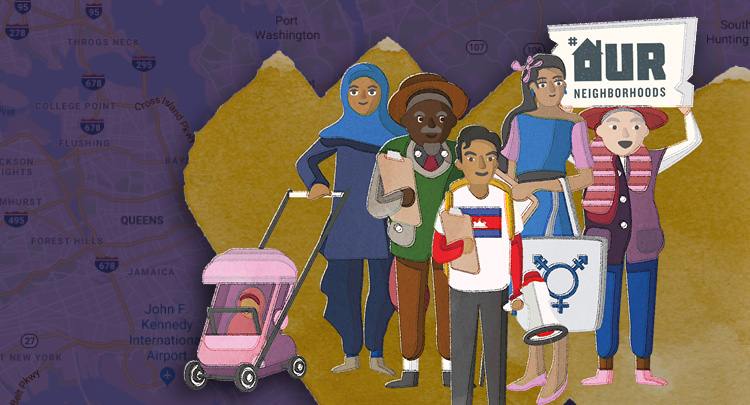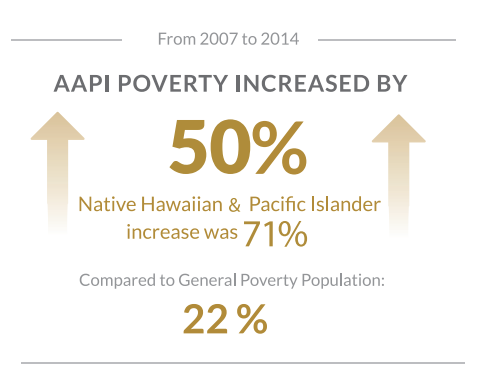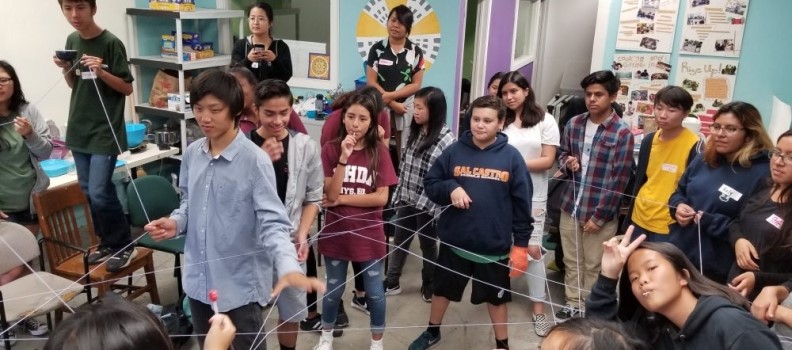Determining the Future of #OurNeighborhoods


The National Coalition for Asian Pacific American Community Development (National CAPACD) recently launched the #OurNeighborhoods anti-displacement toolkit.
The first of its kind, this online resource was developed to provide grassroots organizers in Asian American and Pacific Islander (AAPI) neighborhoods with tools to support their work, including an analysis of gentrification, strategies from the organizing field, examples of successful anti-displacement campaigns, and custom data on housing costs and poverty. National CAPACD is a coalition of nearly 100 community-based organizations spanning 21 states and the Pacific Islands, and we developed the toolkit in close consultation with local groups leading innovative and effective organizing campaigns in AAPI neighborhoods.
Alarmingly, 73% of low-income AAPIs live in the highest-cost housing markets in the country and as a result, they are disproportionately at risk of displacement. Yet even as AAPI neighborhoods across the country witness aggressive development, long-time residents and small businesses continue to be left out of strategy and planning decisions that will determine their fate.
“73% of low-income Asian Americans and Pacific Islanders live in the highest-cost housing markets in the country and as a result, they are disproportionately at risk of displacement.”
AAPI poverty is real, and yet the experiences of AAPIs living in poverty and struggling to survive is obscured by the dominant “model minority” myth, which broadly and falsely assumes that all AAPIs have “made it.” In fact, in 2018 the Pew Research Center confirmed that AAPIs have the greatest income inequality of any racial or ethnic group in the United States today, a data case that we have been making for the past decade.
From 2007 to 2014, AAPI poverty increased by 50% and Native Hawaiian and Pacific Islander poverty increased by 71%, compared to the general poverty population, which increased by 22%. The bifurcated nature of our community means that aggregated data only reinforces prevailing stereotypes. As a result, AAPI leaders and organizations, like National CAPACD, have to justify our need for resources with compelling stories and the minimal publicly available data that reflect the true picture of what low-income AAPIs face.


In the context of rapidly rising rents and living costs, the narrative of AAPI poverty is inextricably linked to the narrative of AAPI displacement. From 2000-2014, nationwide median gross rent increased by 53%, and in neighborhoods with high AAPI populations, median gross rent increased by 74%. AAPI community members are unable to afford to live in neighborhoods that have been their homes, as well as cultural and economic anchors, for decades.
For example, once thriving, D.C.’s Chinatown now holds fewer than 300 Chinese residents. Responding to this crisis, National CAPACD’s members have repeatedly identified displacement resulting from gentrification as a key issue of concern through our annual member survey and policy focus groups. To document their experiences, we released the #OurNeighborhoods: Asian American and Pacific Islander Anti-Displacement Strategies report in 2016, which highlights successful, local anti-displacement strategies in AAPI neighborhoods, and offers policy recommendations. This report illuminates the unique approaches that organizations take to meet the needs of AAPI residents facing gentrification.
Though our 2016 report was a good launch point to lift up AAPI-specific anti-displacement work to our external audiences, groups in our network provided us with feedback on the need for “how-to” resources that provide guidance and practical tools to organize against gentrification and displacement in local communities. After some searching, we found that most national toolkits were not relatable to our network or the communities they serve.
Organizers did not want another report on national policy recommendations; they wanted support to organize buildings in-language, address and overcome fear in AAPI communities, and engage with neighborhood residents with cultural sensitivity. When looking for those kinds of support, they found there was very little information or resources available on local organizing or neighborhood planning, and there was even less information available that is culturally competent or linguistically accessible to diverse AAPI communities.

SEACA’s story, and the stories of so many other groups in our network, impressed upon us the deeper impact that local organizers can have if they do not need to expend so much of their resources and capacity on learning and developing culturally and linguistically-specific content while fighting their campaigns at the same time. Thus, we committed to creating the #OurNeighborhoods toolkit (with support from the Kresge Foundation) to fill the gap in existing resources.
Our team began a lengthy process to intentionally connect with local organizers about the kinds of content our toolkit should contain. After months of group calls, one-on-one check-ins, and a careful review of local content created by organizations in our network, we identified the need to include
To start with, we recognized the need to develop basic definitions of gentrification and displacement (and build some consensus around those definitions) in order to assure all toolkit users start out on the same page.
Guides
The rationality behind our tenant organizing guide is that by organizing tenants who are most at risk of losing their homes to the process of gentrification and displacement, we can prevent evictions and build leadership among those who are most impacted.
We developed the neighborhood organizing guide because we identified the need to develop an organizing strategy for long-term prevention of displacement, and tools that articulate pathways for our communities to engage in the development of their neighborhoods. In the development of this guide, we realized that there are very few materials available to guide organizers through their local planning processes or provide advice on engaging with developers and city agencies. This meant that we needed to dedicate some of our time and resources to developing content that explains zoning and helps local organizers talk about their city development processes.
Stories
We intentionally created a space in the toolkit to include stories of successful and innovative local organizing campaigns because we consistently heard from our network that they wanted to share and learn from best practices around organizing city- and state-wide, especially within AAPI communities. Not only are these stories a tribute to the collective power of our communities — they range from the story of environmental justice advocates who campaigned for a community benefits agreement in the face of a proposed development project in Oakland’s Chinatown, to a group of public housing organizers who advocated for language access in NYC agencies — they can also be re-purposed by local organizations who have limited capacity to document their own stories.
“One of the biggest challenges of organizing in AAPI communities is the constant demand to make a compelling case for ourselves as communities deeply threatened by displacement in our neighborhoods.”
One of the community organization staff members that we connected with shared, “We also appreciate the toolkit because it highlights and celebrates the wins made by groups that have limited capacity and so few spaces to lift those wins up ourselves.” Groups are able to use the case studies we created for them to leverage more resources to fund the work they are already doing.
Data
One of the biggest challenges of organizing in AAPI communities is the constant demand to make a compelling case for ourselves as communities deeply threatened by displacement in our neighborhoods. Yet in trying to build our case, we are often met with a scarcity of data that account for the experience of AAPIs struggling and living in poverty because of the fallacious “model minority” myth. Responding to this scarcity, we offer custom data on poverty and housing costs as an additional resource in our toolkit that local organizers can use to complement their stories, strengthen their campaigns, and build their cases when meeting with decision-makers.
One of the strengths of the #OurNeighborhoods toolkit is that key components are translated into multiple languages. We realized early on that our tools would only be useful if they were also accessible and easy to use.
AAPIs have both high levels of language diversity (fully 77% of Asians and 43% of Native Hawaiians and Pacific Islanders speak a language other than English at home) and high rates of limited English proficiency (40% of Asians and 15% of Native Hawaiians and Pacific Islanders). National CAPACD staff worked with local organizations to identify key languages. Together we identified Bangla, Chinese, Korean, Spanish, and Vietnamese as the languages with the most immediate need among community members.
We worked with local, trusted translators to create the initial versions of these guides, and then each guide was subject to further review by partners to ensure the quality of translation and cultural transferability of shared information. AAPIs are often newer immigrants, and many of the terms used to convey building organizing and neighborhood planning processes in local and national political systems may not have easy or readily available translations in their languages. We needed to ensure both the linguistic quality and cultural adaptability of materials to build the capacity of local organizers to do direct work with limited English proficiency (LEP) community members.
“[W]e wanted local organizers and community members to feel visually connected to the experiences named and guidance offered in the toolkit.”
Another component of the toolkit that has resonated with local organizations is the use of illustrations that are community-centered and culturally relatable. With limited capacity and deep intentionality, we created a set of five character profiles that were broadly inclusive of and relatable to the communities that our network serves.
Local organizers and national partners alike have already remarked on the usefulness of the toolkit, noting its simplicity and accessibility. One youth leader, a high school student, shared back with us that she had scrupulously referred to the toolkit while working on an anti-gentrification campaign with the Asian-American Student Advocacy Project in New York City.
Our hope is that the #OurNeighborhoods toolkit is just the beginning of long-term, sustainable engagement with community groups. Groups organizing in AAPI communities are pouring immeasurable (often unfunded) hours of labor into engaging with community members in a way that they can relate to and understand, that is sensitive to their fears and reservations, and that meets them where they are. National CAPACD is deeply invested in growing institutional support for their work to authentically and meaningfully organize AAPI communities against displacement, as well as the development of practical resources to support their work.
While we need to advocate for increased funding and capacity, our support of local AAPI organizing efforts can and must be deeper. Ultimately, by growing the capacity of local groups to organize AAPI communities in response to gentrification and displacement, we are not trying to silo this work. AAPIs must work with other communities of color in grassroots and national anti-displacement efforts. This work is ultimately about building racial equity into the development process and ensuring that the voices of immigrants, indigenous populations, and communities of color are included in envisioning the future of #OurNeighborhoods.
